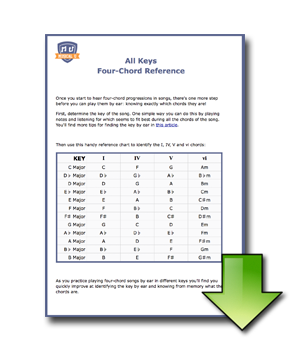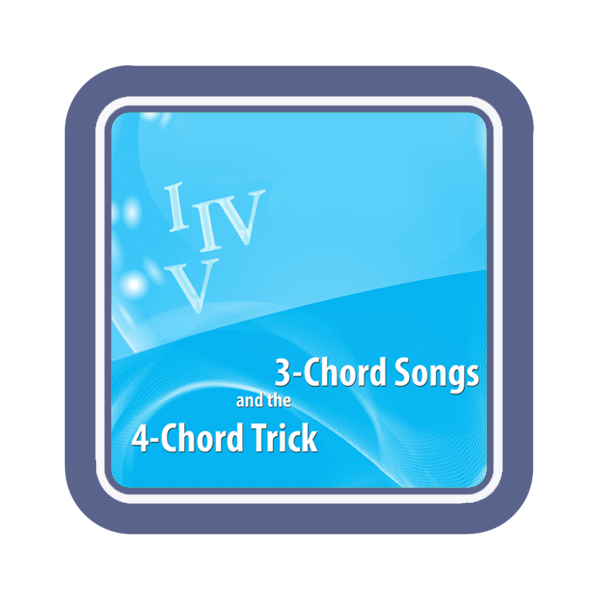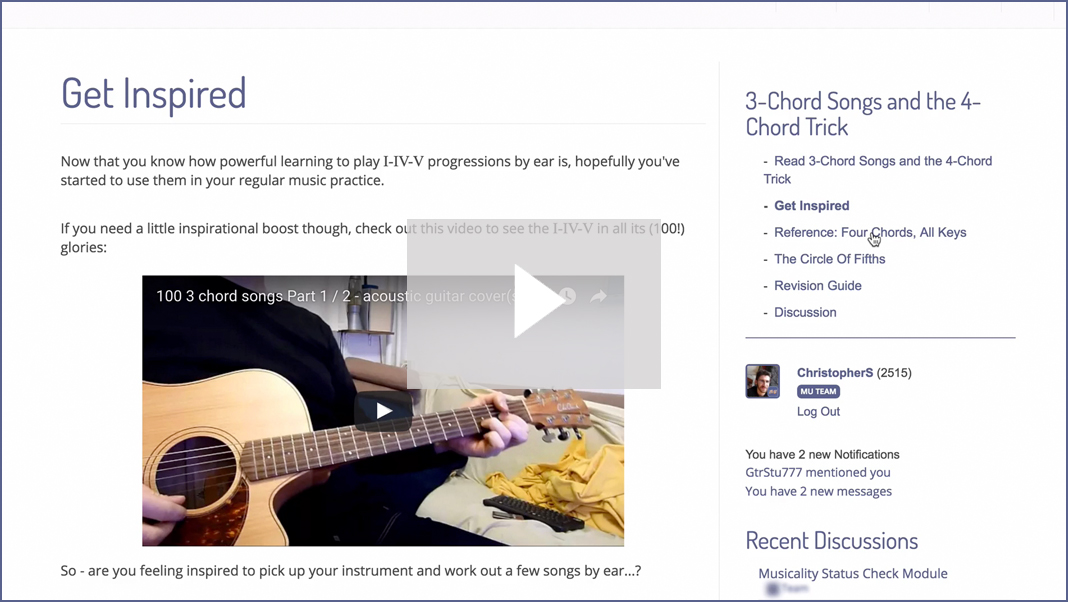Play Chords By Ear Mini-Course
Lesson 2: Why so many songs sound the same
(and how that helps you)
This lesson is based on the 3-Chord Songs and the 4-Chord Trick module from Musical U.
Not yet a member? Click here to preview the module.
LEARN
The Three Chords You Must Know as a Musician
Want to learn to play guitar? Trying to learn how to write pop songs? Need to analyse a 14th Century composition for music theory class?
Understanding the world of chords is essential for all of these, but there’s so much to learn…!
Fortunately there is a particular way to look at chords which is simple – but actually provides the bulk of the understanding you’ll need to build these musical skills!
From the 24 major and minor chords, to all the variants (augmented, extended, and power chords, just to name a few types!), to knowing which can be used when according to complex rules of harmony… There is an awful lot to know about chords! But most of the music we listen to sounds so simple and so natural – surely things can’t be all that complicated?
It turns there are just three chords which are most important to any piece of music. If you want to really improve your music appreciation, learn about these 3 chords.
It’s as easy as 1, 2, 3, 4, 5
Let’s meet the I, IV and V chords and discover their importance in music.
Don’t be discouraged by the use of the strange symbols I, IV and V! If you’re not familiar with roman numerals, that’s just a way of writing “the one, four and five chords”. As you follow along, just read I as “one”, IV as “four” and V as “five”.
We’ll use the famous song “Imagine” by John Lennon as our example of a I–V-IV (“one five four”) progression.
Whether you are just starting to explore music or have been playing an instrument for many years, you have surely heard or read about the I, IV and V chords. These chords are extensively talked about in music theory and for a very good reason; in short, they represent the fundamentals of classical and popular music.
These three chords are considered the backbone, or driving force behind many well-known pieces of music. In fact, there are a huge number of popular pieces of music which use only these three chords! You can buy whole books of 3 chord guitar songs, for example. This is why you should learn to recognise I, IV and V chords by ear.
Whether you are a fan of Mozart or prefer listening to the Beatles, the I, IV and V chords are three chords that you should definitely learn more about.
Read on to find out why the I, IV and V chords are so important in music. We will also be analyzing a few short clips of audio to develop your appreciation of these chords.
PRACTICE
Types of chord
There are a lot of different ways to think about chords. If you play guitar, you probably think in terms of chord boxes and fingering shapes which can be moved up and down the fretboard. A pianist may think in terms of the visual pattern on the keyboard or relate them to the corresponding scales.
When we talk about I, IV and V, we’re actually looking at things slightly differently, in a way that’s more familiar to the song writer or composer.
These ‘degree’ labels let us talk about what chords do and how they sound without getting bogged down in key signatures and sharps and flats and fingering and so on. If what you’re interested in is hearing chords and the impact they have on a song’s sound, this roman numeral (or ‘degree’) analysis is the way to go.
Just one catch: You can’t directly hear a “I chord” or a “IV chord” – we do need to pick a key for our examples. We’ll use the key of C, which means our I, IV and V chords are C, F and G major respectively. Explanation below!
For now, just take a listen to these three chords:
The I chord
The one chord is also referred to as the ‘tonic’ chord. This chord will usually let you know what key a song is written in. As we said above, the I chord isn’t a particular chord; it depends on the tonality of a song. For example, if you wrote a song in the key of F, your I chord would be F. However, if your song is written in C, the I chord would be C.
Because the I chord matches the key, it is the most important of all the chords in that key, and the other chords used will all have a sound based on their relation to the I chord.
The I chord is what sparks the beginning of the song and is also what the song usually comes back to at the end, in a cycle.
Listen to the example below, which is the chords to “Imagine” by John Lennon. Notice how each musical phrase starts with C and comes back to it. This is the I chord of the song!
The IV chord
The IV chord will be a chord based on the fourth degree of your tonality. The term ‘degree’ just means where that note occurs in the key’s scale.
For example, in our example song above the I chord was C major. From the C major scale, we know the fourth note will be F. This means that the IV chord of this song is F major. Simple as that!
There’s another relationship here that is interesting to look at: because C is the fifth note in an F Major scale, if our key is F, then F becomes our I chord and C will be our V chord. This is actually one of the reasons that these two particular chords work so well together. We will learn later the dominance of the “V-I” sound, but in short: going from I to IV (e.g. C to F) is also using that particular dominance.
Because the root note of the I chord is one of the notes in the IV chord, it makes it very easy to go from IV to I or I to IV seamlessly in music. Having this note in common links the sound of the two chords.
Listen again to the clip of Imagine, and notice this time how the transition from the last chord (F or “IV“) back to the first (C or “I“) is pleasing to the ears and feels natural.
APPLY
As this mini-course continues you’ll want to start connecting your new skills with your instrument. To do that we need to put the I, IV and V chords into a particular key, like the C Major example above.
We have a handy chart to tell you what the I, IV and V chords are in each key, as a bonus gift to go along with this mini-course. If you didn’t already, you can download it here:
The songs you’re going to play by ear in this course are in the keys of E Major, F Major and G Major so it would be good to make sure you can play the I, IV and V chords in those keys.
So your task for today is to use the chart above to look up the I, IV and V chords in those three keys and make sure you know how to play them on your instrument. If you need help just leave a comment in the “Discussion” area below.
Tip: This is a great time to start playing around with the I, IV and V chords to get familiar with their sounds. We’ll be using some specific exercises in the next few days, but for now just use your instrument and the keys mentioned above to experiment with moving between the three chords and listening to the sound.
So, are you starting to hear the relationship between these 3 chords?
Great!
In the next few lessons we’re going to practice recognising these chords by ear and start using those skills to play real songs by ear.
“Chords By Ear”
email mini-course
Not signed up yet?
Click here
Discussion
Musical U membership includes full personal support and guidance on your training.
Although we can’t provide the same level of in-depth coaching as part of this free course, please post any questions you have in the comments below and we’ll do our best to help!





 This free lesson is based on the 3-Chord Songs and the 4-Chord Trick module of Musical U.
This free lesson is based on the 3-Chord Songs and the 4-Chord Trick module of Musical U.